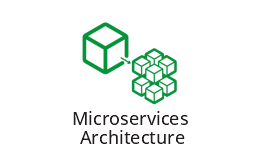Overview
Microservices architecture is an architectural style that structures an application as a collection of loosely coupled services. Each service is independent, has its own database, and is responsible for a specific business capability. Microservices are designed to be small, modular, and scalable, making it easier to develop, test, deploy, and maintain individual services. This architecture contrasts with traditional monolithic applications, where all components are tightly integrated. Microservices communicate with each other through lightweight protocols such as HTTP/REST or messaging systems.

Key Features:
- Decoupled Services: Services are loosely coupled, allowing each one to be developed, deployed, and scaled independently.
- Independent Databases: Each service manages its own data, which improves fault isolation and scalability.
- Scalability: Services can be scaled independently based on their specific resource requirements.
- Continuous Delivery/Deployment: Enables faster and more frequent releases, as individual services can be updated without affecting the whole system.
- Fault Isolation: A failure in one service does not necessarily lead to a system-wide failure, improving reliability.
Use Cases:
- Large-scale, distributed applications
- Cloud-native applications
- Applications with high scalability requirements
- E-commerce platforms with multiple services (e.g., payment, inventory, user management)
